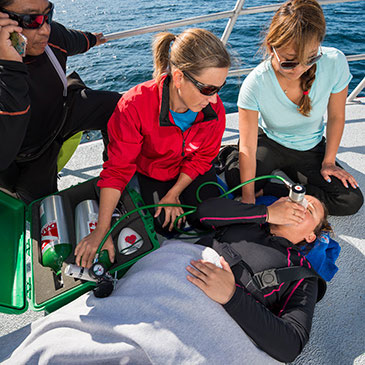Lesson 135
Learning Objectives
By the end of this session, I should be able to answer these questions:
1. What is meant by decompression illness?
2. What is the first aid for a diver with suspected decompression illness? What treatment is usually required?
Decompression Illness
Lung overexpansion injuries and decompression sickness can produce very similar signs and symptoms, even though they result from different causes. The first aid for both is the same, so you don’t need to tell them apart. For simplicity in dealing with diver emergencies, therefore, the dive community uses the term decompression illness (DCI) for both lung overexpansion injuries and decompression sickness.

A Prudent Measure
Statistically, the incidence of DCI is very, very low. If you follow accepted, conservative diving practices and stay within your limits, the risk of DCI is also very low.
But the risk is not zero. The cost of recompression can be significant, and may not be entirely covered by normal medical insurance. In most areas, you can get diver accident insurance very inexpensively. This insurance is highly recommended if available for your area. Diver accident insurance:
- May reduce treatment delays caused by questions over who will pay for the treatment.
- Provides coverage for expenses that regular medical insurance often doesn’t cover, such as air ambulance and recompression.
Your PADI dive shop or Dive Instructor can recommend a dive accident insurance provider for your area.
It’s your responsibility not only to dive safely, but to be prepared if something happens. Diver accident insurance is simply too affordable not to have.
Helping a Diver with Suspected DCI
If a diver is suspected of having decompression illness, follow the steps you learned in Section Three:
- The diver should stop all diving.
- Check for breathing. Provide CPR as needed.
- Contact emergency medical care. Some areas have diver emergency services for consultation and to coordinate with local medical services.

- Keep the diver lying down and provide emergency oxygen.
- Monitor the diver and take steps to prevent shock.
- If the diver is unresponsive but breathing normally, lay the diver level, left side down, head supported, breathing oxygen.
- Continue this care until emergency medical personnel arrive.
Almost all cases of decompression illness require treatment in a recompression chamber. Recompression puts the diver under pressure, which helps the body absorb the gas bubbles present. The pressure is then lowered very slowly over many hours.
Don’t delay first aid and getting the diver to treatment. The faster treatment begins, the lower the risk of permanent residual symptoms. The PADI Rescue Diver and Emergency Oxygen Provider courses, and the Emergency First Response Primary and Secondary Care courses, are recommended for learning more about managing diver emergencies.
PADI Emergency Oxygen Provider Course
Most countries and territories allow laypeople to give emergency oxygen to a diver with suspected DCI. However, some require or recommend special (nonprofessional) training in emergency oxygen administration.
The PADI Emergency Oxygen Provider course gives you specific training in the handling and use of typical emergency oxygen systems used in diving emergencies. It qualifies you to give emergency oxygen to divers with suspected DCI (and patients in other emergency situations). You complete the PADI Emergency Oxygen Provider course as a step toward PADI Rescue Diver, and you can take it immediately. Ask your PADI dive shop about how to enroll.
knowledge review and quiz
Comments

I'll take you diving!
Copyright © Larry Wedgewood Scuba Instruction All Rights Reserved















